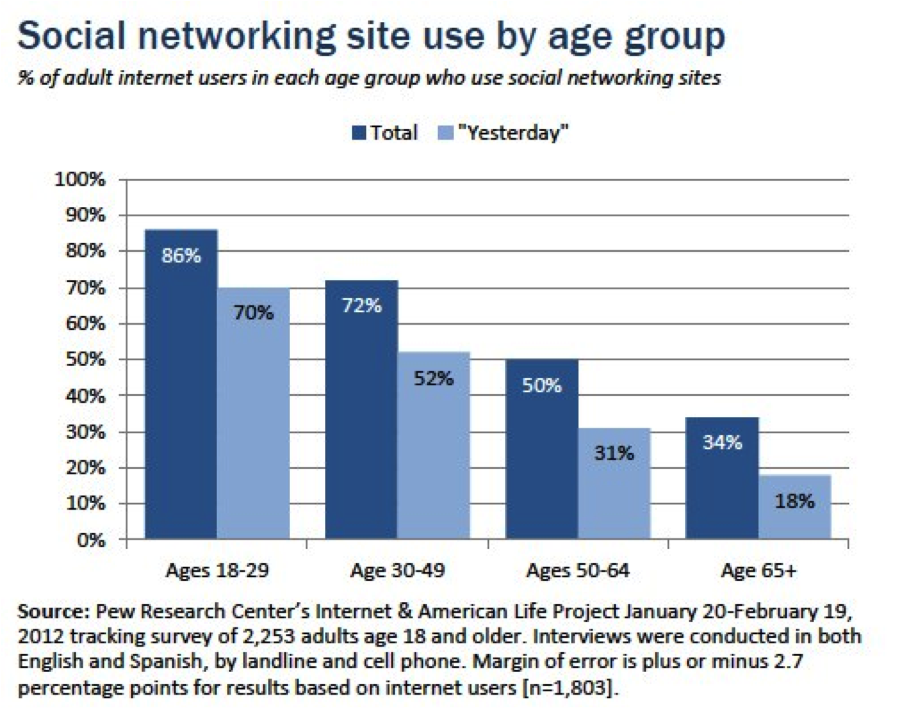 More than half of U.S. adults 65 and older are now online.
More than half of U.S. adults 65 and older are now online.
This surprising outtake (of the “we knew it was going to happen, but now it’s here” ilk) is one of the most crucial findings in the Older adults and Internet Use report recently released by Pew Internet. The trend centers on younger seniors 65 to 75, with Internet use dropping off significantly after age 75.
Once they’re online, seniors return frequently with 70% using the internet on a daily basis.

Seniors Go Social to Stay Connected
Although email remains the “killer app” for seniors, Facebook and other social networking sites are growing in popularity, and are used by one in three online seniors.

What’s particularly fascinating is that online seniors are using tools like Facebook to bridge the social gaps they face in increasingly isolated lives. Seniors’ social lives are narrowed as they grow older and are separated from friends and family due to distance, health care needs, and limitations such as not driving.
According to researcher Shyam Sundar, founder of the Media Effects Research Laboratory at Penn State University (and quoted in a recent story on WNYC), “We need to make up for that potential social isolation, and we think that online social networking sites can be a good solution.”
Social Can Work to Strengthen Relationships
Of course online connections are an adjunct to face-to-face visits. But according to a February 2012 survey conducted by AARP, 30% of grandparents and 29% of young adults report that connecting online has helped them understand each other.
My warm, fun, lovely father—who’s 89—yearns to be more connected but isn’t comfortable online. Human interaction with friends and family is his greatest want, and I know that seeing and sharing updates and photos via Facebook would be a great joy to him, if he was more comfortable online.
But of course many seniors don’t have family, or enough family, or just want more.
Your Organization Can Provide the Community and Interaction Online Seniors Crave
These findings from Pew Internet and AARP—indicating that isolated seniors are looking to social networks to help build and strengthen relationships—has huge implications for your nonprofit.
Fundraising-wise, young seniors are a primary audience to cultivate. They are the prospect segment most likely to give as a one off or for the long term.
The Pew research shows how online seniors crave more interaction and community and that’s just what your organization can provide—via email and Facebook. AARP’s Facebook fans have exploded in number and engagement, growing from 80,000 to 350,000 count in the first six months of this year alone, says Tammy Gordon, AARP’s Director of Social Communications & Strategy.
Guidelines for Success with Online Seniors
Here are some guidelines to build relationships that are long lasting and fulfill what online seniors want:
- Add a few online seniors to your marketing advisory group.
- Listen hard, and be extremely responsive, in a timely manner.
- Tone-wise, err on the side of the formal, at least to begin with. Respect is the name of the game.
- Make new tools and online services intuitive and easy to use. My gut is that online seniors will be easily frustrated. They’re online for satisfaction, not because they have to be.
- Design your website and Facebook pages to be accessible for all including those with weak eyes and less-than-ideal hand-eye coordination.
- Help online seniors become active members your organization’s online community (senior help desk)
How is your organization building relationships with online seniors? Please share your stories below in the comments section.
*Nancy Schwartz blogs at http://gettingattention.org/


COMMENTS